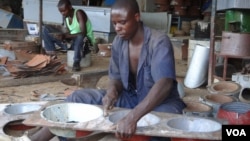A campaign to persuade people in Rwanda to buy a new improved type of cooking stove - which uses less fuel and is less smoky - hasn't succeeded, according to the stoves' manufacturers. They say the public still doesn't realize this type of stove could save them money and protect their health, as well as save trees.
There are various types of improved cooking stoves in Rwanda. One of the most affordable is a combined ceramic and metal charcoal stove called a canamake.
Three years ago, the Rwandan Ministry of Infrastructure approved a new more durable type of canamake, fired in a kiln to prevent breakage. The ministry said it wanted 80 percent of households in the capital Kigali to be using this charcoal stove.
The new type saves about 30 percent on charcoal compared with unimproved stoves, and 11 percent compared to the old canamake, according to the international NGO Practical Action, which helped to design it.
But it costs about $7.50 whereas the old canamake stove costs a little over two dollars.
It’s not known how many of the new canamake are being produced in Kigali but according to one of the manufacturers, the AJDR cooperative, it’s not many, and sales are falling because the government has removed a subsidy.
‘Not selling’
Alain Nsanzabaganwa, treasurer of the AJDR co-op, says they not selling many of their improved stoves, they are not getting enough publicity and they are hardly selling at all outside Kigali.
In the past year, he said, the cooperative sold just 1,600 of the new canamake.
Nsanzabaganwa thinks there are about six places in Kigali where the public can buy the new canamake. One of these is a market in Kimironko district.
Deep inside the market is a stall with a few stacks of cooking stoves. There were none of the new stoves on display when VOA arrived there but one was produced when we asked for it. It had a tag with the maker’s certificate.
The stove vendor, Laurence Uwamahoro, said she sells about five of the model each month and 30 of the older model.
She said it was more economical than the other stoves, but when asked if she had one herself she said no, as the eight dollar price tag was too much for her.
For rich people
A bystander remarked that the new stove is for rich people.
You might think Rwandans are crazy not to save up seven dollars for a stove which could save them well over a hundred dollars in charcoal if it lasts for two years, as the makers claim.
The saving may not be that great if they already have the old canamake, but even in that case the saving could amount to a few $10 sacks of charcoal.
Practical Action’s consultant in Rwanda, Ewan Bloomfield, tells VOA there needs to be more clarity about marketing, and it should be sold door to door, which is not happening at the moment.
"My understanding of the types of approaches which are most effective are when sales agents are able to go and physically visit a household, and explain to them the benefits, give them a demonstration of the benefits, and then get back-up from another woman or another person of authority in the community who can then demonstrate to them the actual tangible benefits of the stove," said Bloomfield.
Currently, added Bloomfield, the cooking stove manufacturers don’t seem to understand the importance of the retail side of the business.








